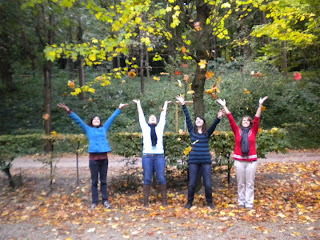Prague was a fabulous trip. The SA group with the assistance of a tour guide was shown around the Old City, the Jewish Quarter, and the Prague Palace. An on-looker could have easily thought our group had never been anywhere colder than Hawaii. We looked like penguins, huddled together for warmth. I don't know what the temperature was, but the mornings were particularly cold.
This is a government building. Frankly I think it's a bit intimidating since it can be seen from all the way down the street.
Walking along the expensive shopping street, we decided to cut through a covered alleyway. It had a pretty glass ceiling.
Welcoming us to Oldtown Prague was a gorgeous clock tower.
In the background is a church, but I call it the Maleficent Towers. We happened to come during the "Käse und Speise Fest". Basically it was a festival for cheese, gourmet cakes, and delicious main meals. On the last day in Prague, this square was packed with people. I couldn't walk two feet without running into someone holding potato wedges.
Here is another church.
This is the famous Charles Bridge. It's the prettiest pedestrian bridge.
Across the river is the Palace and cathedral. The tallest building is the cathedral.
The John Lennon Wall was super cool! It was riddled with quotes from the Beatles and miscellaneous love and peace gestures.
Nearby was the lock bridge. It's a very small bridge, but its real importance lies with the symbolism of the locks. Two lovers will inscribe their names onto a lock, fasten it on the cast iron grate of the bridge, and throw the key into the river.
Walking up to the Palace was pretty.
The acoustics under the fountain sing… supposedly. It was a stretch to call it singing. However, I like listening to water anyway.
Here is the Palace cathedral.
The gargoyle makes me laugh.





















































